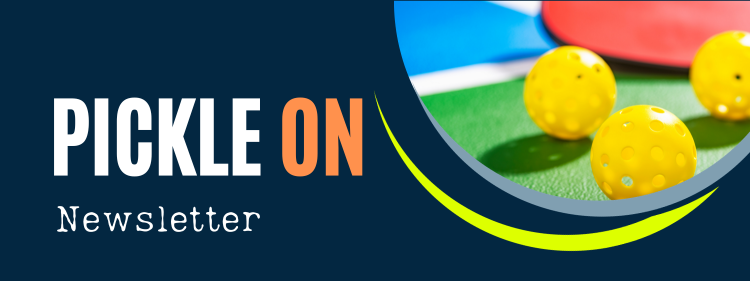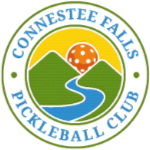
Happy holidays one and all!
It’s that time of year again…Thanksgiving has come and gone and while there are still Black Friday deals to be found (and we’ve got a few in here!) the holidays are here.
The pretty leaves are (mostly) gone, but we’re still battling them on the courts–MANY thanks to Tom Hunter and his group of volunteers who keep the courts blown and ready for play. Don’t forget, we have blowers in the shed if you need one!
In this issue, we’re getting into the mechanics of mixed play–did you know there’s a big difference between playing with the opposite sex and playing with your own? Well there is…stay tuned to find out why.
Also, do you drill? Well you should! Find out how this often overlooked part of becoming a good player will help you out in a big, big way.
Got a couple of codes for you for Black Friday if you want Santa to bring you a new shiny paddle!
And as we go into the holidays with all the food, libations and festivities, remember that a good game of pickleball can burn some major calories–like 500-700 in a 2 hour session so pass the Christmas cookies, haha.
See you on the courts!
Pickle ON!


Playing mixed doubles in pickleball involves a combination of strategy, teamwork, and effective communication.
Here are 10 tips and strategies for playing mixed doubles in pickleball effectively, especially for rec play:
1. Understanding Roles:
– Typically, the male player is expected to be more aggressive and cover more court, especially in put away opportunities.
– The female player is often positioned to guard the sideline and reset with her soft game skills. However, roles can vary based on each player’s strengths and the way the game is going.
2. Communication:
– Constant communication is crucial. Call shots early and clearly to avoid confusion. Figure out who is going to be the “team captain” to call the shots (mine, yours, etc.). Remember to allow plenty of time (as possible) to tell your partner what’s up!
– Discuss strategies, like switching sides, poaching, stacking and even signals if you’re that advanced, before the match.
3. Serve and Return Strategy:
– Serve deep to push your opponents back and gain the advantage early.
– On the return, aim for deep and accurate shots to prevent the serving team from quickly gaining the net. This is true whether you’re playing mixed or not.
4. Positioning:
– You want to avoid as much as possible having both of you being at the baseline, as it gives the net advantage to the opponents. Watch the big gap between you, but get up to the kitchen!
-Decide on who handles the middle beforehand.
5. Dinking and Soft Game:
– Use dinks to reset and control the pace. Look for opportunities to attack. Patience isn’t just a virtue, it’s a discipline. (Deb Richter quote)
– Develop a strong soft game, as many points in mixed doubles are won at the net with a dink going right into the net from an impatient player.
6. Poaching:
– Poaching can be an effective strategy. It keeps your opponents guessing and can create offensive opportunities.
– Coordinate with your partner on when and how to poach effectively.
– Both men AND women can become effective poachers!
7. Play to Your Strengths:
– Utilize each player’s strengths, whether it’s power, precision, speed, or strategy.
-Remember, you’re playing with a PARTNER. Unless you have an agreement ahead of time, this isn’t the time to become your partner’s pickleball instructor.
8. Respect and Support Your Partner:
– Stay positive and supportive, regardless of the score. Encourage your partner when he or she is not playing well. There’s nothing like having someone tell you, you’ve got this when you feel bad for how you’re playing!
– Keep the discussion on what went wrong for after the game. And even then, constructive and positive is always the plumb line to keep a partnership from becoming bitter.
9. Adaptability:
– Be prepared to adapt your strategy based on your opponents’ play style and strengths. What worked for some, might not work for all. Stay flexible.
10. Practice Together:
– Regular practice as a team is essential to develop chemistry and a deeper understanding of each other’s play style. You can’t walk out cold and expect to play well–it takes time to develop a true partnership.
The key to success in mixed doubles pickleball is working cohesively as a team, leveraging each player’s strengths, and maintaining a positive and adaptive approach throughout the game.
Women know they will be targeted by their male opponents and your teammate will do the same thing so remember to talk about that and include how you’ll handle it in your strategy.
All of this applies to rec play, but is especially important in tournaments.
If you want to see great mixed doubles pickleball, watch some games on YouTube with Anna Leigh Waters and Ben Jons–that’s how it’s done.
And just for fun, if you’re on Facebook (and you should be–Connestee Falls Pickleball Club has their own page, like and follow for all the fun!) watch this video on the stages of mixed double play. HAHAHA!

A few times a week, you’ll see me and a number of other women, out on the courts, drilling.
Why?
Because drilling is all about improving your skills, consistency and having a better overall performance when it’s game time.
I have literally fallen on my face learning new skills (I have the pics)–but it’s through drilling that I figured out how to actually stay upright and get the shot instead of faceplanting.
The more I drill, the better I play. The better I play with improved skills, the more I can figure out strategies and angles and more–that’s because drilling helps to automate your skills and give you muscle memory instead of a lesson on the pavement.
Here are 12 ways drilling can help you:
1. Improves Technique: Regular drilling helps in refining and perfecting your shots. This includes everything from forehand and backhand shots, serves, volleys, drops and dinking. Better technique leads to more consistent and effective shots and way less unforced errors.
2. Increases Consistency: Consistent drilling ingrains muscle memory. The more you practice a particular shot, the more automatic it becomes, leading to greater consistency during actual play. If you know, you know…it’s a great day when that starts to happen.
4. Improves Footwork and Mobility: Many drills focus on movement around the court, enhancing a player’s agility, balance, and footwork. Good footwork is crucial for getting into the right position to make great shots. Your split step should be part of your dynamic warm up before a game!
5. Develops Strategic Play: Drills can also focus on strategies such as shot placement, dinking, and lobbing. Practicing these strategies during your drilling can help you better implement them in games. It’s better to have practiced lobbing in a drill sesh than to try it in the middle of heated game!
6. Enhances Endurance and Speed: Drilling can improve your physical endurance and speed, essential for longer, more competitive matches–which you’ll be playing because as you drill, you get better and your games get longer and more fun.
7. Boosts Reaction Time: Drills that involve quick hands or a fast change in direction can enhance your reaction time–crucial if you end up in a battle at the net!
8. Promotes Mental Toughness: Regular drilling not only enhances physical skills but also mental aspects of the game. It teaches you to maintain focus, stay patient (and disciplined), and handle the pressure.
9. Allows for Specific Skill Focus: Drills can be tailored to target specific weaknesses in your game, allowing for focused and effective improvement. Shoutout to Deb for teaching me to lob correctly!
10. Facilitates Adaptability: By practicing a variety of shots and scenarios, you become more adaptable and able to handle different styles of play. This is especially important if you’re playing in All Play and are the lone woman on the court.
11. Encourages Controlled Practice Environment: Drills provide a controlled environment to practice and make mistakes without the pressure of a competitive match–ideal for trying new techniques and strategies.
12. Feedback and Adjustment: Lastly, drills provide an opportunity for immediate feedback and adjustments, which leads to quicker improvement and implementation (play a game after you drill!).
I hope you can see how important drilling is and how it can greatly improve your game. Figure out how to get out there and get it done. Watch some videos on how to do some of these drills or just ask–there’s a lot of experience here at Connestee!

Pickleball Central has a ton going on–check out their paddles and use our club code CRMP to get an extra 5% off. Visit Pickleball Central HERE
CRBN has a great deal on paddles–Visit CRBN HERE. Use the code 25AM235 to get a screaming good deal of 25% off–good till 12/3/23.
That’s it for this edition–see you next month!
Pickle ON!
